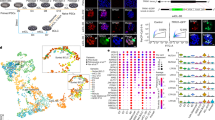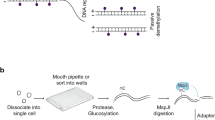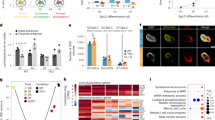Abstract
Parthenogenetic embryonic stem (pES) cells provide a valuable in vitro model system for studying the molecular mechanisms that underlie genomic imprinting. However, the pluripotency of pES cells and the expression profiles of paternally expressed imprinted genes have not been fully explored. In this study, three mouse pES cell lines were established and the differentiation potential of these cells in extended culture was evaluated. The undifferentiated cells had a normal karyotype and homozygous genome, and expressed ES-cell-specific molecular markers. The cells remained undifferentiated after more than 50 passages and exhibited pluripotent differentiation capacity. All three lines of the established ES cells produced teratomas; two lines of ES cells produced chimeras and germline transmission. Furthermore, activation of the paternally expressed imprinted genes Snrpn, U2af1-rs1, Peg3, Impact, Zfp127, Dlk1 and Mest in these cells was detected. Some paternally expressed imprinted genes were found to be expressed in the blastocyst stage of parthenogenetically activated embryos in vitro and their expression level increased with extended pES cell culture. Furthermore, our data show that the activation of these paternally expressed imprinted genes in pES cells was associated with a change in the methylation of the related differentially methylated regions. These findings provide direct evidence for the pluripotency of pES cells and demonstrate the association between the DNA methylation pattern and the activation of paternally expressed imprinted genes in pES cells. Thus, the established ES cell lines provide a valuable model for studying epigenetic regulation in mammalian development.
Similar content being viewed by others
Log in or create a free account to read this content
Gain free access to this article, as well as selected content from this journal and more on nature.com
or
References
Tesar PJ . Derivation of germ-line-competent embryonic stem cell lines from preblastocyst mouse embryos. Proc Natl Acad Sci USA 2005; 102:8239–8244.
Smith AG . Embryo-derived stem cells: of mice and men. Annu Rev Cell Dev Biol 2001; 17:435–462.
Thomson JA, Itskovitz-Eldor J, Shapiro SS, et al. Embryonic stem cell lines derived from human blastocysts. Science 1998; 282:1145–1147.
Dowdy SC, Gostout BS, Shridhar V, et al. Biallelic methylation and silencing of paternally expressed gene 3 (PEG3) in gynecologic cancer cell lines. Gynecol Oncol 2005; 99:126–134.
Kim K, Lerou P, Yabuuchi A, et al. Histocompatible embryonic stem cells by parthenogenesis. Science (New York, NY) 2007; 315:482–486.
Vrana KE, Hipp JD, Goss AM, et al. Nonhuman primate parthenogenetic stem cells. Proc Natl Acad Sci USA 2003; 100 Suppl 1:11911–11916.
Lin H, Lei J, Wininger D, et al. Multilineage potential of homozygous stem cells derived from metaphase II oocytes. Stem Cells 2003; 21:152–161.
Allen ND, Barton SC, Hilton K, Norris ML, Surani MA . A functional analysis of imprinting in parthenogenetic embryonic stem cells. Development 1994; 120:1473–1482.
Newman-Smith ED, Werb Z . Stem cell defects in parthenogenetic peri-implantation embryos. Development 1995; 121:2069–2077.
Jagerbauer EM, Fraser A, Herbst EW, Kothary R, Fundele R . Parthenogenetic stem cells in postnatal mouse chimeras. Development 1992; 116:95–102.
Park JI, Yoshida I, Tada T, et al. Differentiative potential of a mouse parthenogenetic embryonic stem cell line revealed by embryoid body formation in vitro. Jpn J Vet Res 1998; 46:19–28.
McGrath J, Solter D . Completion of mouse embryogenesis requires both the maternal and paternal genomes. Cell 1984; 37:179–183.
Haig D . Genomic imprinting and kinship: how good is the evidence? Annu Rev Genet 2004; 38:553–585.
Delaval K, Feil R . Epigenetic regulation of mammalian genomic imprinting. Curr Opin Genet Dev 2004; 14:188–195.
Mitalipov SM . Genomic imprinting in primate embryos and embryonic stem cells. Reprod Fertil Dev 2006; 18:817–821.
Lopes S, Lewis A, Hajkova P, et al. Epigenetic modifications in an imprinting cluster are controlled by a hierarchy of DMRs suggesting long-range chromatin interactions. Hum Mol Genet 2003; 12:295–305.
da Rocha ST, Ferguson-Smith AC . Genomic imprinting. Curr Biol 2004; 14:R646–R649.
Sotomaru Y, Kawase Y, Ueda T, et al. Disruption of imprinted expression of U2afbp-rs/U2af1-rs1 gene in mouse parthenogenetic fetuses. J Biol Chem 2001; 276:26694–26698.
Dean W, Bowden L, Aitchison A, et al. Altered imprinted gene methylation and expression in completely ES cell-derived mouse fetuses: association with aberrant phenotypes. Development 1998; 125:2273–2282.
Mitalipov SM, Nusser KD, Wolf DP . Parthenogenetic activation of rhesus monkey oocytes and reconstructed embryos. Biol Reprod 2001; 65:253–259.
Liu L, Ju JC, Yang X . Parthenogenetic development and protein patterns of newly matured bovine oocytes after chemical activation. Mol Reprod Dev 1998; 49:298–307.
Xu HM, Liao B, Zhang QJ, et al. Wwp2, an E3 ubiquitin ligase that targets transcription factor Oct-4 for ubiquitination. J Biol Chem 2004:23495–23503.
Keller GM . In vitro differentiation of embryonic stem cells. Curr Opin Cell Biol 1995; 7:862–869.
Li JY, Lees-Murdock DJ, Xu GL, Walsh CP . Timing of establishment of paternal methylation imprints in the mouse. Genomics 2004; 84:952–960.
Schumacher A, Doerfler W . Influence of in vitro manipulation on the stability of methylation patterns in the Snurf/Snrpn-imprinting region in mouse embryonic stem cells. Nucleic Acids Res 2004; 32:1566–1576.
Surani MA, Barton SC . Development of gynogenetic eggs in the mouse: implications for parthenogenetic embryos. Science (New York, NY) 1983; 222:1034–1036.
Kim K, Lerou P, Yabuuchi A, et al. Histocompatible embryonic stem cells by parthenogenesis. Science 2007; 315:482–486.
Barton SC, Surani MA, Norris ML . Role of paternal and maternal genomes in mouse development. Nature 1984; 311:374–376.
Kaufman MH, Robertson EJ, Handyside AH, Evans MJ . Establishment of pluripotential cell lines from haploid mouse embryos. J Embryol Exp Morphol 1983; 73:249–261.
Kono T, Obata Y, Wu Q, et al. Birth of parthenogenetic mice that can develop to adulthood. Nature 2004; 428:860–864.
Poirier F, Chan CT, Timmons PM, et al. The murine H19 gene is activated during embryonic stem cell differentiation in vitro and at the time of implantation in the developing embryo. Development 1991; 113:1105–1114.
Sun BW, Yang AC, Feng Y, et al. Temporal and parental-specific expression of imprinted genes in a newly derived Chinese human embryonic stem cell line and embryoid bodies. Hum Mol Genet 2006; 15:65–75.
Andrieu D, Watrin F, Niinobe M, et al. Expression of the Prader-Willi gene Necdin during mouse nervous system development correlates with neuronal differentiation and p75NTR expression. Gene Expr Patterns 2003; 3:761–765.
Szabo P, Mann JR . Expression and methylation of imprinted genes during in vitro differentiation of mouse parthenogenetic and androgenetic embryonic stem cell lines. Development 1994; 120:1651–1660.
Yang T, Adamson TE, Resnick JL, et al. A mouse model for Prader-Willi syndrome imprinting-centre mutations. Nat Genet 1998; 19:25–31.
Lefebvre L, Viville S, Barton SC, et al. Abnormal maternal behaviour and growth retardation associated with loss of the imprinted gene Mest. Nat Genet 1998; 20:163–169.
Sotomaru Y, Katsuzawa Y, Hatada I, et al. Unregulated expression of the imprinted genes H19 and Igf2r in mouse uniparental fetuses. J Biol Chem 2002; 277:12474–12478.
Acknowledgements
The study was supported by grants from the Project of Shanghai Science & Technology Developmental Foundation (No. 04DZ14006), Chinese Academy of Sciences and Shanghai Jiao Tong University School of Medicine.
Author information
Authors and Affiliations
Corresponding authors
Rights and permissions
About this article
Cite this article
Jiang, H., Sun, B., Wang, W. et al. Activation of paternally expressed imprinted genes in newly derived germline-competent mouse parthenogenetic embryonic stem cell lines. Cell Res 17, 792–803 (2007). https://doi.org/10.1038/cr.2007.70
Received:
Accepted:
Published:
Issue date:
DOI: https://doi.org/10.1038/cr.2007.70
Keywords
This article is cited by
-
Ascorbic acid improves pluripotency of human parthenogenetic embryonic stem cells through modifying imprinted gene expression in the Dlk1-Dio3 region
Stem Cell Research & Therapy (2015)
-
High-throughput sequencing reveals the disruption of methylation of imprinted gene in induced pluripotent stem cells
Cell Research (2014)
-
Derivation of androgenetic embryonic stem cells from m-carboxycinnamic acid bishydroxamide (CBHA) treated androgenetic embryos
Chinese Science Bulletin (2013)
-
Derivation of haploid embryonic stem cells from mouse embryos
Nature (2011)
-
Quantitative proteomics analysis of parthenogenetically induced pluripotent stem cells
Protein & Cell (2011)



